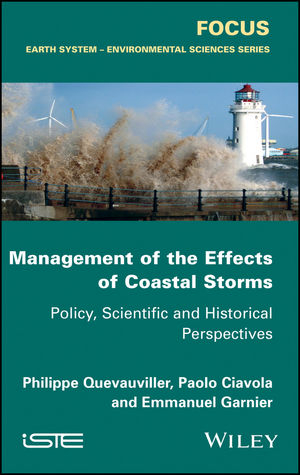
Management of the Effects of Coastal Storms
ISTE Ltd and John Wiley & Sons Inc (Verlag)
978-1-84821-762-1 (ISBN)
A large part of the world’s coastlines consists of sandy beaches and dunes that may undergo dramatic changes during storms. Extreme storm events in some cases dominate the erosion history of the coastline and may have dramatic impacts on densely populated coastal areas. Policy, research and historical background are essential elements that need to be interconnected for effective coastal planning and management.
This book discusses this framework, with Chapter 1 providing an insight into policy settings and science-policy interactions in the area of coastal risks related to storms and flooding, and integrated coastal zone management. This is followed by a review of the current understanding of the processes generating extreme coastal events, the morphological evolution of coastlines during and after the events, and the methods for monitoring the process as it occurs or for post-event appraisal. The final chapter discusses the importance of historical approaches regarding coastal threats, taking the Xynthia storm as an example.
Philippe Quevauviller, Vrije Universiteit Brussel, Belgium. Paolo Ciavola, University of Ferrara, Italy. Emmanuel Garnier, CNRS, France.
Preface ix
Chapter 1 Coastal Storms and Flooding: Regulatory Framework and Science–Policy Interactions 1
1.1 Introduction 1
1.2 Natural hazards and risks in coastal zones: needs to build-up a “culture of risks” 4
1.2.1 Introduction 4
1.2.2 Contribution of environmental policy to the development of a “culture of risks” 5
1.2.3 Toward an integrated management of coastal zones 9
1.2.4 Regional instruments 10
1.2.5 Emerging “culture of risk” beyond the environment legal framework? 13
1.2.6 Ecosystem services: a new orientation of environmental policies or an opportunity of risk socialization? 14
1.2.7 The international society facing (coastal) natural hazards: between protection of human rights and challenges of international security 15
1.3 Policy background 17
1.3.1 International policies 17
1.3.2 EU policies 19
1.4 Science–policy interactions 26
1.4.1 Scientific foundation of coastal risk policies 26
1.4.2 EU Scientific framework in support of coastal risk-related policies 28
1.4.3 Identification of research needs in the coastal risk-related policy sectors 29
1.4.4 Interactions with the scientific community 31
1.4.5 Science-based development of an integrated coastal risks policy 34
1.5 Research trends 35
1.5.1 Introduction 35
1.5.2 EU-funded instruments 36
1.5.3 Examples of research trends 38
1.6 Science–policy interfacing 44
1.6.1 Linking different actors 44
1.6.2 Governance and knowledge transfer 45
1.6.3 Networking needs 48
1.6.4 Who are the users of research? 49
1.6.5 Building-up of a “Community of Users” 50
1.7 Conclusions 57
Chapter 2 Techniques for the Assessment of Coastal Storm Risk 61
2.1 Introduction 61
2.2 Definition of coastal risk 65
2.3 Hazard time series in Europe and beyond 66
2.3.1 Short term: hours to days 70
2.3.2 Medium- and long term 71
2.4 Evaluation of coastal vulnerability 72
2.4.1 Evaluation on the basis of critical thresholds 72
2.4.2 Coastal risk maps 73
2.4.3 Topographic and bathymetric surveys 76
2.4.4 Estimation of wave parameters 82
2.4.5 Wave set-up 83
2.4.6 Wave run-up 85
2.4.7 Numerical models for beach dynamics 88
2.4.8 Development of vulnerability zones 89
2.4.9 Development of damage curves 90
2.4.10 Input-output economic model 91
2.4.11 Climate change scenario and predicted losses 91
2.5 Toward disaster risk reduction 92
2.5.1 Monitoring the storm impact 92
2.5.2 Operational Early Warning Systems for surges 96
2.5.3 Operational Early Warning Systems for beach morphological changes 104
2.6 Outlook for the future: a EU-wide system? 106
2.7 Conclusions 108
Chapter 3 Xynthia, February 2010: Autopsy of a Foreseable Catastrophe 111
3.1 Introduction 111
3.2 Scenario of the crisis 112
3.2.1 French coastlines 112
3.2.2 La Faute-sur-Mer: “martyred” city 117
3.2.3 The “unprecedented dogma” 121
3.3 The historical verdict 124
3.3.1 At the national and European levels 124
3.3.2 The example of La Faute-sur-Mer 128
3.4 The construction of the coastal vulnerability 134
3.4.1 The time of the precautionary principle (Middle Age – 1900) 134
3.4.2. The choice to live close to the sea (1900–2016). 138
3.4.3 A national symbol: La Faute-sur-Mer 143
Conclusion 149
Bibliography 153
Index 171
| Erscheinungsdatum | 06.04.2017 |
|---|---|
| Verlagsort | London |
| Sprache | englisch |
| Maße | 158 x 239 mm |
| Gewicht | 249 g |
| Themenwelt | Naturwissenschaften ► Geowissenschaften ► Geologie |
| Naturwissenschaften ► Geowissenschaften ► Hydrologie / Ozeanografie | |
| Naturwissenschaften ► Geowissenschaften ► Meteorologie / Klimatologie | |
| ISBN-10 | 1-84821-762-5 / 1848217625 |
| ISBN-13 | 978-1-84821-762-1 / 9781848217621 |
| Zustand | Neuware |
| Haben Sie eine Frage zum Produkt? |
aus dem Bereich


